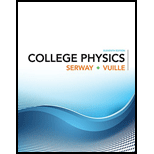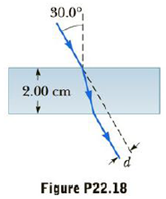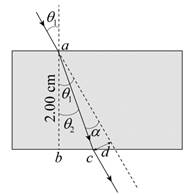
Concept explainers
A ray of light strikes a flat, 2.00-cm-thick block of glass (n = 1.50) at ail angle of 30.0° with respect to the normal (Fig. P22.18). (a) Find the angle of refraction at the lop surface. (b) Find the angle of incidence at the bottom surface and the refracted angle. (c) Find the lateral distance d by which the light beam is shifted. (d) Calculate the

(a)
Answer to Problem 18P
Explanation of Solution
From Snell’s law, at the first surface,
Here,
Substitute
Conclusion:
Thus, the angle of refraction at the top surface is
(b)
Answer to Problem 18P
Explanation of Solution
The upper surface and the lower surface are parallel, the angle of incidence at the lower surface will be
The angle of refraction is,
Substitute
Conclusion:
Thus, the angle of incidence at the bottom surface is
(c)
Answer to Problem 18P
Explanation of Solution
The following diagram shows the sketch of the path of the ray.

From the figure,
Also,
Thus, the lateral distance by which the light beam is shifted is,
Conclusion:
Thus, the lateral distance by which the light beam is shifted is
(d)
Answer to Problem 18P
Explanation of Solution
The equation for the speed of light in glass is,
Substitute
Conclusion:
Thus, the speed of light in the glass is
(e)
Answer to Problem 18P
Explanation of Solution
The equation for time required for the light to travel through the glass is,
Substitute
Conclusion:
Thus, the time required for the light to travel through the glass is
(f)
Answer to Problem 18P
Explanation of Solution
A change in the angle of incidence will cause a change in the angle of refraction. Thus, the distance the distance travelled by the light also changes. So, the travel time will also change.
Conclusion:
Yes, the travel time through the block is affected by the angle of incidence.
Want to see more full solutions like this?
Chapter 22 Solutions
College Physics
- The object in Figure P23.52 is mid-way between the lens and the mirror, which are separated by a distance d = 25.0 cm. The magnitude of the mirrors radius of curvature is 20.0 cm, and the lens has a focal length of 16.7 cm. (a) Considering only the light that leaves the object and travels first toward the mirror, locate the final image formed by this system. (b) Is the image real or virtual? (c) Is it upright or inverted? (d) What is the overall magnification of the image? Figure P23.52arrow_forwardThe left face of a biconvex lens has a radius of curvature of magnitude 12.0 cm, and the right face has a radius of curvature of magnitude 18.0 cm. The index of refraction of the glass is 1.44. (a) Calculate the focal length of the lens for light incident from the left. (b) What If? After the lens is turned around to interchange the radii of curvature of the two faces, calculate the focal length of the lens for light incident from the left.arrow_forwardThe object in Figure P23.52 is mid-way between the lens and the mirror, which are separated by a distance d = 25.0 cm. The magnitude of the mirrors radius of curvature is 20.0 cm, and the lens has a focal length of 16.7 cm. (a) Considering only the light that leaves the object and travels first toward the mirror, locate the final image formed by this system. (b) Is the image real or virtual? (c) Is it upright or inverted? (d) What is the overall magnification of the image? Figure P23.52arrow_forward
- Figure P26.72 shows a thin converging lens for which the radii of curvature of its surfaces have magnitudes of 9.00 cm and 11.0 cm. The lens is in front of a concave spherical mirror with the radius of curvature R = 8.00 cm. Assume the focal points F1 and F2 of the lens are 5.00 cm from the center of the lens. (a) Determine the index of refraction of the lens material. The lens and mirror are 20.0 cm apart, and an object is placed 8.00 cm to the left of the lens. Determine (b) the position of the final image and (c) its magnification as seen by the eye in the figure. (d) Is the final image inverted or upright? Explain.arrow_forwardFigure P36.95 shows a thin converging lens for which the radii of curvature of its surfaces have magnitudes of 9.00 cm and 11.0 cm. The lens is in front of a concave spherical mirror with the radius of curvature R = 8.00 cm. Assume the focal points F1 and F2 of the lens are 5.00 cm from the center of the lens, (a) Determine the index of refraction of the lens material. The lens and mirror are 20.0 cm apart, and an object is placed 8.00 cm to the left of the lens. Determine (b) the position of the filial image and (c) its magnification as seen by the eye in the figure. (d) Is the final image inverted or upright? Explain.arrow_forwardQuestions 20 through 22 are concerned with the situation sketched as shown, in which a beam of light in the air encounters a transparent block with index of refraction n = 1.53. Some of the light is reflected and some is refracted. Is there an angle of incidence between 0° and 90° such that all of the light will be reflected?A. Yes, at an angle greater than 50°B. Yes, at an angle less than 50°C. Noarrow_forward
- A ray of light strikes a flat,2.00-cm-thick block of glass(n = 1.50) at an angle of 30.0°with respect to the normal (Fig.P22.18). (a) Find the angle ofrefraction at the top surface. (b)Find the angle of incidence at thebottom surface and the refractedangle. (c) Find the lateral distanced by which the light beam isshifted. (d) Calculate the speed oflight in the glass and (e) the time required for the light topass through the glass block. (f) Is the travel time through theblock affected by the angle of incidence? Explain.arrow_forwardA block of crown glass is immersed in water as in the figure shown below. A light ray is incident on the top face at an angle of ?1 = 45.8° with the normal and exits the block at point P. (Assume that x = 3.48 cm.) (a) Find the vertical distance y from the top of the block to P. cm(b) Find the angle of refraction ?2 of the light ray leaving the block at P. °arrow_forwardThe object in Figure P23.52 is midwaybetween the lens and the mirror,which are separated by a distance d =25.0 cm. The magnitude of the mirror’sradius of curvature is 20.0 cm,and the lens has a focal length of-16.7 cm. (a) Considering only thelight that leaves the object and travelsfirst toward the mirror, locate the final image formed by thissystem. (b) Is the image real or virtual? (c) Is it upright orinverted? (d) What is the overall magnification of the image?arrow_forward
 College PhysicsPhysicsISBN:9781285737027Author:Raymond A. Serway, Chris VuillePublisher:Cengage Learning
College PhysicsPhysicsISBN:9781285737027Author:Raymond A. Serway, Chris VuillePublisher:Cengage Learning College PhysicsPhysicsISBN:9781305952300Author:Raymond A. Serway, Chris VuillePublisher:Cengage Learning
College PhysicsPhysicsISBN:9781305952300Author:Raymond A. Serway, Chris VuillePublisher:Cengage Learning Principles of Physics: A Calculus-Based TextPhysicsISBN:9781133104261Author:Raymond A. Serway, John W. JewettPublisher:Cengage Learning
Principles of Physics: A Calculus-Based TextPhysicsISBN:9781133104261Author:Raymond A. Serway, John W. JewettPublisher:Cengage Learning Physics for Scientists and Engineers, Technology ...PhysicsISBN:9781305116399Author:Raymond A. Serway, John W. JewettPublisher:Cengage Learning
Physics for Scientists and Engineers, Technology ...PhysicsISBN:9781305116399Author:Raymond A. Serway, John W. JewettPublisher:Cengage Learning Physics for Scientists and Engineers: Foundations...PhysicsISBN:9781133939146Author:Katz, Debora M.Publisher:Cengage Learning
Physics for Scientists and Engineers: Foundations...PhysicsISBN:9781133939146Author:Katz, Debora M.Publisher:Cengage Learning




